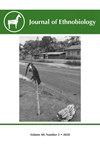Dynamic Edible Plant Theoretical Knowledge in a Changing Western Mexican Rural Community
IF 1.3
3区 社会学
Q1 ANTHROPOLOGY
引用次数: 0
Abstract
Abstract. The ability to name plants is part of one's theoretical botanical knowledge, which is neither static nor presented equally among all members of a cultural group. This article analyzes the intracultural variation of knowledge in the cultural domain of edible plant species among a rural population of western Mexico. We evaluate individuals' capacity to name plants, the salience of each plant, children's sources of this knowledge, and the socioeconomic factors that influence the amount of knowledge held. Freelists on local edible plant species were generated from 107 participants, including 37 children of middle childhood (MC), 27 preteens (PT), and 43 adults (A). A total of 102 species were mentioned across the lists for all three age groups. While each age and gender group presented variation in the species mentioned, a high level of overlap was found among the salient species. Group A mentioned twice the number of wild species as the PT and MC groups. Vertical knowledge transmission was more important for the children, and their ability to name the species differed significantly according to age, gender, and mother's occupation. Children with farmer-housewife mothers listed five more species on average than those with mothers in other occupational groups. The children listed fewer plants than adults, indicating differences between age groups and indicating the need for future studies to evaluate the factors that influence the transmission of knowledge amidst socioenvironmental changes.变化中的墨西哥西部农村社区动态食用植物理论知识
摘要命名植物的能力是一个人植物学理论知识的一部分,它既不是静态的,也不是在一个文化群体的所有成员中平等呈现的。本文分析了墨西哥西部农村人口中食用植物物种文化领域知识的文化内变异。我们评估了个人命名植物的能力,每种植物的显著性,儿童对这些知识的来源,以及影响知识持有量的社会经济因素。从107名参与者中生成了关于当地可食用植物物种的自由列表,其中包括37名儿童(MC), 27名学龄前儿童(PT)和43名成年人(A)。在所有三个年龄组的列表中,共有102种植物被提及。虽然各年龄和性别组在上述物种中存在差异,但在突出物种中发现高度重叠。A组提到的野生物种数量是PT和MC组的两倍。垂直知识传播对儿童更为重要,其物种命名能力因年龄、性别和母亲职业的不同而存在显著差异。母亲是农民家庭主妇的孩子比母亲是其他职业的孩子平均多出5个物种。孩子们列出的植物比成年人少,这表明了年龄组之间的差异,也表明了未来研究需要评估在社会环境变化中影响知识传播的因素。
本文章由计算机程序翻译,如有差异,请以英文原文为准。
求助全文
约1分钟内获得全文
求助全文
来源期刊

Journal of Ethnobiology
Social Sciences-Anthropology
CiteScore
4.80
自引率
3.40%
发文量
21
审稿时长
>12 weeks
期刊介绍:
JoE’s readership is as wide and diverse as ethnobiology itself, with readers spanning from both the natural and social sciences. Not surprisingly, a glance at the papers published in the Journal reveals the depth and breadth of topics, extending from studies in archaeology and the origins of agriculture, to folk classification systems, to food composition, plants, birds, mammals, fungi and everything in between.
Research areas published in JoE include but are not limited to neo- and paleo-ethnobiology, zooarchaeology, ethnobotany, ethnozoology, ethnopharmacology, ethnoecology, linguistic ethnobiology, human paleoecology, and many other related fields of study within anthropology and biology, such as taxonomy, conservation biology, ethnography, political ecology, and cognitive and cultural anthropology.
JoE does not limit itself to a single perspective, approach or discipline, but seeks to represent the full spectrum and wide diversity of the field of ethnobiology, including cognitive, symbolic, linguistic, ecological, and economic aspects of human interactions with our living world. Articles that significantly advance ethnobiological theory and/or methodology are particularly welcome, as well as studies bridging across disciplines and knowledge systems. JoE does not publish uncontextualized data such as species lists; appropriate submissions must elaborate on the ethnobiological context of findings.
 求助内容:
求助内容: 应助结果提醒方式:
应助结果提醒方式:


